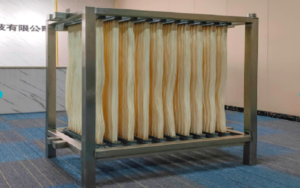Sewage disposal has become a necessary step in the current society as a way of addressing water pollution and effective usage of water. Of all the technologies that have been designed to offer this kind of solution, the Membrane Bioreactor (MBR) is one of the most efficient and most improved. Membrane Bioreactor for wastewater treatment is a process that integrates both biological degradation and membrane filtration giving improved efficiency of wastewater treatment, better water quality, and compact structures. This guest post discusses what MBR is, its parts, how it operates, its benefits and shortcomings, as well as its uses in treating wastewater.
Defining the Membrane Bioreactor (MBR)
Membrane Bioreactor for wastewater treatment technology combines an attached or suspended culture Biofilm biomass treatment system with membrane-based filtration. The membranes employed in the system provide the mechanical means of excluding solids and microorganisms from reaching the treated water. This technology guarantees the generation of a high-standard effluent that needs to be recycled and reused in different sectors such as industrial uses and agriculture.
Each of the two types of Membrane Bioreactor systems has some of the following important components:
Submerged (or Immersed) MBR: In the case of the membrane modules, they are installed directly in the biological reactor.
Side-stream MBR: The membrane modules are situated on the outer sides, and mixed liquor is obliged to flow through these membranes.
Components of Membrane Bioreactor
Biological Reactor: This is the place where sewage-borne microorganisms break down organic substances in the wastewater. It therefore replicates natural biodegradation, but does so at a faster rate thus enhancing the elimination …
Membrane Module: The module of the developed system is ultrafiltration or microfiltration membranes, which separate the treated water from the biomass. Such membranes are characterized by pore sizes in the range of 0.01 μm to 0.1 μm.
Aeration System: In the biological reactor, aeration is required for oxygen transfer to the microorganisms, while in the membrane unit, it is required to minimize fouling of the
Membrane surface through inducing turbulence.
Permeate Pump: This pump forces the treated water and pass through the membrane system and go to the storage or reuse system.
Working Principle of Membrane Bioreactors
The Membrane Bioreactor for wastewater treatment process consists of two major stages:
Biological Treatment: Wastewater is fed into the bioreactor, where a complex microbial community breaks down organic matter, nutrients, and contaminants. The microorganisms form a mixed liquor-suspended solids (MLSS) solution that enhances the treatment efficiency.
Membrane Filtration: Water is filtered through the membranes, which form a barrier to bacteria, suspended solids, and even viruses. The process results in effluent with low turbidity and few contaminants.
In Membrane Bioreactor for wastewater treatment, compared to conventional wastewater treatment plants, the separation of liquid and solid occurs in the membranes and does not require secondary clarifiers.
Advantages of Membrane Bioreactors
Membrane Bioreactor for wastewater treatment technology has many advantages over other conventional wastewater treatment systems such as
High-Quality Effluent: The membranes’ fine pore size ensures the removal of suspended solids, pathogens, and some dissolved contaminants, which makes the effluent suitable for reuse.
Compact Design: The integration of biological treatment and membrane filtration reduces the system’s footprint, which makes it ideal for urban and space-constrained applications.
Flexibility in Operation: MBR systems adapt to varying wastewater characteristics, making them suitable for municipal and industrial wastewater treatment.
Less Sludge Formation: The high biomass concentration in the reactor reduces the formation of sludge and, hence, the costs of disposal.
Energy Saving: Submerged MBR configurations have less energy consumption compared to conventional systems with separate clarifiers.
Challenges Involved in MBR Systems
Although Membrane Bioreactor for wastewater treatment have many advantages, there are some challenges involved with them, such as
Membrane Fouling: The biological and chemical fouling can gradually occur in membranes, thereby reducing the permeability and efficiency of these membranes. It is a constant requirement for cleaning and maintaining the membranes to prevent fouling.
High Capital Costs: The MBR system has high capital costs in comparison with the conventional treatment technologies mainly due to membrane cost and the infrastructure for it.
Energy Use: Though MBRs are energy efficient, aeration and permeate pumping could be higher in operational energy costs compared to some of the traditional processes.
Membrane Replacement: Membranes have a finite life and require replacement from time to time. This contributes to operational costs.
Applications of MBR Technology
Hinada’s MBR systems have found utility in many applications because of their versatility.
Municipal Wastewater Treatment: Membrane Bioreactor for wastewater treatment applications are common in urban WWTPs to meet more stringent discharge requirements and water reuse.
Industrial Wastewater Treatment: Pharmaceutical, textile, and food processing industries adopt MBR technology for complex wastewater streams containing high levels of organic and chemical contamination.
Water Reuse Projects: MBR-treated effluent is increasingly used in irrigation, cooling systems, and industrial processes, helping in sustainable water management.
Decentralized Treatment Systems: Due to their compact size, MBRs are ideal for decentralized wastewater treatment in small communities, hotels, and remote locations.
Future Prospects of MBR Technology
The utilization of Membrane Bioreactor for wastewater treatment systems is only anticipated to increase due to increasing concerns about water shortage and stringer environmental policies. New advances in membrane technology, foulant management, and energy optimization hold the MBR systems’ potential to achieve better economic and performance efficiencies in the future. Furthermore, the inclusion of MBRs with other tertiary treatment methods such as reverse osmosis and advanced oxidation results in enhanced WWT efficiency.
Summary
Hinada’s Membrane Bioreactor for wastewater treatment is a new concept in the field of wastewater treatment that combines both theological processes and membrane technologies to give the highest level of efficiency and quality of effluent. Despite the constraints such as membrane fouling and high costs, advancement in MBR technology is progressing to provide the much-needed solution to the ever-increasing demand for water reuse and possibly help in solving environmental problems in the long run. Hence, MBR systems will have an important position in future water treatment challenges due to the development of membrane technology and systematic architecture design.
FAQs
What is an MBR system?
MBR is a system in which biological treatment and membrane filtration of wastewater are integrated in order to achieve effective and efficient wastewater treatment and produce high-quality effluent.
What are the types of membranes used in MBR?
In the case of MBRs, the membranes used are mostly ultrafiltration (UF) and microfiltration (MF) with an ore range of 0.01m to 0.1 m.
What are the frequent problems associated with MBR systems?
There are problems in membrane fouling, high capital costs, energy, loss, and sometimes membrane replacement.


